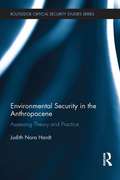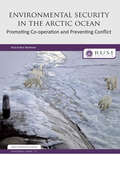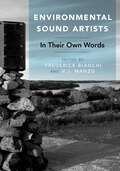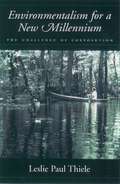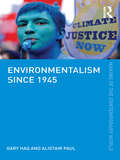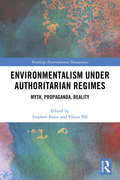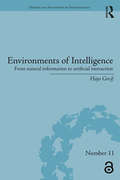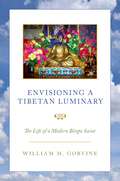- Table View
- List View
Environmental Security in the Anthropocene: Assessing Theory and Practice (Routledge Critical Security Studies)
by Judith Nora HardtThis book provides a critical assessment of the theories and practice of environmental security in the context of the Anthropocene. The work analyses the intellectual foundations, the evolution and different interpretations, strengths and potential of the link between environment and security, but also its weaknesses, incoherencies and distortions. To do so, it employs a critical environmental security studies analytical framework and uniquely places this analysis within the context of the Anthropocene. Furthermore, the book examines the practice–theory divide, and the political implementation of the environmental security concept in response to global environmental change and in relation to different actors. It pays significant attention to the Environment and Security Initiative (ENVSEC), which is led by different programs of the United Nations, the OSCE and until recently by the North Atlantic Treaty Organization (NATO), among others, and has largely been overlooked in the academic literature to date. The goal is to study how environmental security practice could inform and shape the environmental security theory, and also to explore how, conversely, new theoretical insights could contribute to the enhancement of environmental security activities. This book will be of great interest to students and academic scholars of Environmental Security, Critical Security Studies, Green Political Theory, Global Governance and International Relations in general.
Environmental Security in the Anthropocene: Assessing Theory and Practice (Routledge Critical Security Studies)
by Judith Nora HardtThis book provides a critical assessment of the theories and practice of environmental security in the context of the Anthropocene. The work analyses the intellectual foundations, the evolution and different interpretations, strengths and potential of the link between environment and security, but also its weaknesses, incoherencies and distortions. To do so, it employs a critical environmental security studies analytical framework and uniquely places this analysis within the context of the Anthropocene. Furthermore, the book examines the practice–theory divide, and the political implementation of the environmental security concept in response to global environmental change and in relation to different actors. It pays significant attention to the Environment and Security Initiative (ENVSEC), which is led by different programs of the United Nations, the OSCE and until recently by the North Atlantic Treaty Organization (NATO), among others, and has largely been overlooked in the academic literature to date. The goal is to study how environmental security practice could inform and shape the environmental security theory, and also to explore how, conversely, new theoretical insights could contribute to the enhancement of environmental security activities. This book will be of great interest to students and academic scholars of Environmental Security, Critical Security Studies, Green Political Theory, Global Governance and International Relations in general.
Environmental Security in the Arctic Ocean: Promoting Co-operation and Preventing Conflict (Whitehall Papers)
by Paul Arthur BerkmanThe North Pole is being transformed from a sea-ice cap to a seasonally ice-free sea within the next few decades. This fundamental shift in the boundary conditions of the Arctic Ocean will create a new natural system with different dynamics than anything previously experienced by humans in the region. With the diminishing ice cover, interests are awakening globally to take advantage of extensive energy, shipping, fishing and tourism prospects in the Arctic Ocean. A range of states, including the major Arctic powers, are increasingly asserting their sovereignty seawards. National security policies are being declared and nuclear-capable states are adjusting their strategic deployments in the Arctic Ocean. There are forums for international cooperation in the Arctic, most notably the Arctic Council, but peace in the Arctic Ocean has yet to be explicitly established as a common interest because of the long-standing military presence. Risks of political, economic and cultural instabilities are inherent consequences. This volume proposes environmental security as providing a holistic framework to assess these security risks and then identify the appropriate adaptation and mitigation responses. Only after shared risk assessment and understanding of the appropriate responses, will there be sufficient clarity about the governance paths to pursue within the international legal framework of the law of the sea.
Environmental Security in the Arctic Ocean: Promoting Co-operation and Preventing Conflict (Whitehall Papers)
by Paul Arthur BerkmanThe North Pole is being transformed from a sea-ice cap to a seasonally ice-free sea within the next few decades. This fundamental shift in the boundary conditions of the Arctic Ocean will create a new natural system with different dynamics than anything previously experienced by humans in the region. With the diminishing ice cover, interests are awakening globally to take advantage of extensive energy, shipping, fishing and tourism prospects in the Arctic Ocean. A range of states, including the major Arctic powers, are increasingly asserting their sovereignty seawards. National security policies are being declared and nuclear-capable states are adjusting their strategic deployments in the Arctic Ocean. There are forums for international cooperation in the Arctic, most notably the Arctic Council, but peace in the Arctic Ocean has yet to be explicitly established as a common interest because of the long-standing military presence. Risks of political, economic and cultural instabilities are inherent consequences. This volume proposes environmental security as providing a holistic framework to assess these security risks and then identify the appropriate adaptation and mitigation responses. Only after shared risk assessment and understanding of the appropriate responses, will there be sufficient clarity about the governance paths to pursue within the international legal framework of the law of the sea.
Environmental Sound Artists: In Their Own Words
Environmental Sound Artists: In Their Own Words is an incisive and imaginative look at the international environmental sound art movement, which emerged in the late 1960s. The term environmental sound art is generally applied to the work of sound artists who incorporate processes in which the artist actively engages with the environment. While the field of environmental sound art is diverse and includes a variety of approaches, the art form diverges from traditional contemporary music by the conscious and strategic integration of environmental impulses and natural processes. This book presents a current perspective on the environmental sound art movement through a collection of personal writings by important environmental sound artists. Dismayed by the limitations and gradual breakdown of contemporary compositional strategies, environmental sound artists have sought alternate venues, genres, technologies, and delivery methods for their creative expression. Environmental sound art is especially relevant because it addresses political, social, economic, scientific, and aesthetic issues. As a result, it has attracted the participation of artists internationally. Awareness and concern for the environment has connected and unified artists across the globe and has achieved a solidarity and clarity of purpose that is singularly unique and optimistic. The environmental sound art movement is borderless and thriving.
ENVIRONMENTAL SOUND ARTISTS C: In Their Own Words
by V. J. Manzo Frederick BianchiEnvironmental Sound Artists: In Their Own Words is an incisive and imaginative look at the international environmental sound art movement, which emerged in the late 1960s. The term environmental sound art is generally applied to the work of sound artists who incorporate processes in which the artist actively engages with the environment. While the field of environmental sound art is diverse and includes a variety of approaches, the art form diverges from traditional contemporary music by the conscious and strategic integration of environmental impulses and natural processes. This book presents a current perspective on the environmental sound art movement through a collection of personal writings by important environmental sound artists. Dismayed by the limitations and gradual breakdown of contemporary compositional strategies, environmental sound artists have sought alternate venues, genres, technologies, and delivery methods for their creative expression. Environmental sound art is especially relevant because it addresses political, social, economic, scientific, and aesthetic issues. As a result, it has attracted the participation of artists internationally. Awareness and concern for the environment has connected and unified artists across the globe and has achieved a solidarity and clarity of purpose that is singularly unique and optimistic. The environmental sound art movement is borderless and thriving.
Environmental Thought: A Short History
by Robin AttfieldEnvironmental thought has a rich and extensive history. Philosopher Robin Attfield guides readers through the key developments and debates that have defined the field from ancient times to the present. Attfield investigates ancient, medieval and early modern environmental contributions; Darwin and his successors; the debate in America involving Thoreau, Marsh, Muir and Pinchot; the foundation of the science of ecology in the Western world; and twentieth century trailblazers like Aldo Leopold and Rachel Carson. Central themes of key environmentalist works of the 1970s and 1980s are discussed, along with the major debates in environmental philosophy, including Lovelock’s Gaia hypothesis. Attfield then turns to the current environmental emergency, encompassing the crises of climate change, air pollution and biodiversity loss, exploring contemporary intellectual responses to it. Each chapter concludes with a list of recommended readings, selected to invite readers to explore the book’s topics in greater depth. Environmental Thought: A Short History will become a pivotal text in its field, of interest to students and scholars of history, philosophy, ethics, geography, religion, biology and environmental studies.
Environmental Thought: A Short History
by Robin AttfieldEnvironmental thought has a rich and extensive history. Philosopher Robin Attfield guides readers through the key developments and debates that have defined the field from ancient times to the present. Attfield investigates ancient, medieval and early modern environmental contributions; Darwin and his successors; the debate in America involving Thoreau, Marsh, Muir and Pinchot; the foundation of the science of ecology in the Western world; and twentieth century trailblazers like Aldo Leopold and Rachel Carson. Central themes of key environmentalist works of the 1970s and 1980s are discussed, along with the major debates in environmental philosophy, including Lovelock’s Gaia hypothesis. Attfield then turns to the current environmental emergency, encompassing the crises of climate change, air pollution and biodiversity loss, exploring contemporary intellectual responses to it. Each chapter concludes with a list of recommended readings, selected to invite readers to explore the book’s topics in greater depth. Environmental Thought: A Short History will become a pivotal text in its field, of interest to students and scholars of history, philosophy, ethics, geography, religion, biology and environmental studies.
The environmental turn in postwar Sweden: A new history of knowledge (Lund University Press)
by David Larsson HeidenbladThe Stockholm Conference of 1972 drew the world’s attention to the global environmental crisis, but for people in Sweden the threat was nothing new. Anyone who read the papers or watched the television news was already familiar with the issues. Five years early, in the summer of 1967, the situation was very different. So what happened in between? This book explores the ‘environmental turn’ that took place in Sweden in the late-1960s. This radical change, the realisation that human beings were in the process of destroying their own environment, had major and far-reaching consequences. What was it that opened people’s eyes to the crisis? When did it happen? Who set the ball rolling? These are some of the questions the book addresses, shedding new light on the history of environmentalism.
The environmental turn in postwar Sweden: A new history of knowledge (Lund University Press)
by David Larsson HeidenbladThe Stockholm Conference of 1972 drew the world’s attention to the global environmental crisis, but for people in Sweden the threat was nothing new. Anyone who read the papers or watched the television news was already familiar with the issues. Five years early, in the summer of 1967, the situation was very different. So what happened in between? This book explores the ‘environmental turn’ that took place in Sweden in the late-1960s. This radical change, the realisation that human beings were in the process of destroying their own environment, had major and far-reaching consequences. What was it that opened people’s eyes to the crisis? When did it happen? Who set the ball rolling? These are some of the questions the book addresses, shedding new light on the history of environmentalism.
Environmental Warfare in Gaza: Colonial Violence and New Landscapes of Resistance
by Shourideh C. Molavi“Almost entirely written before the catastrophic events of late 2023, this book anticipates them, exposing the brutal history of crimes against trees, plants and the people who live with them along the 300-mile border zone between Gaza and Israel, as nothing less than 75 years of colonization” Laura Kurgan, Professor, Columbia University“A timely and very essential addition for understanding the multi-layered story of Gaza, and that of Palestine. Beyond the familiar warfare in Gaza, the book presents a unique tale of Israeli violence to reengineer the Palestinian environment” Ahmad Amara, lawyer and lecturer, Al-Quds University“Provides a much-needed historical context to understand unfolding events in light of the long history of Palestinian liberation struggles through the lens of environmental history” Paulo Tavares, architect and authorThe engineered perimeter around the occupied Gaza Strip is formed by a sophisticated system of fences, forts and surveillance technologies. With each Israeli incursion, a military no-go area, or a “buffer zone”, is established along its “borders”, extending deep into Palestinian communities and farmlands in Gaza. These practices reproduce Israel’s eco-colonial imaginary, further compounding the Gaza Strip’s isolation from the rest of Palestine.Since 2014, the bulldozing of Palestinian lands by Israeli occupation forces has been complemented by the unannounced aerial spraying of military herbicides, extending the reach of Israeli colonial violence into the realm of chemical warfare. The spraying has destroyed entire swaths of arable land in Gaza, contributing to decades-long practices that have forcibly changed a once-lush Palestinian landscape.This book is a vivid document of this aspect of Israeli eco-colonial warfare and the strategies of anti-colonial resistance adopted by Palestinians in Gaza as a result. It includes original maps, images and visualizations, and collects new documents, original archival materials, stills of drone footage, first-hand testimonies of farmers, organizers and protesters, and documents affected vegetation in Gaza as “silent witnesses” to Israeli settler-colonial violence.Shourideh C. Molavi is a writer and scholar specializing in citizenship, statelessness and human rights. She is the dedicated Palestine-Israel researcher at Forensic Architecture, an independent research agency based in London, and teaches at the Institute for the Study of Human Rights at Columbia University. She is the author of Stateless Citizenship: The Palestinian-Arab Citizens of Israel.
Environmentalism
by David Peterson Del MarWhy are our environmental problems still growing despite a huge increase in global conservation efforts? Peterson del Mar untangles this paradox by showing how prosperity is essential to environmentalism. Industrialization drove people to look for meaning in nature even as they consumed its products more relentlessly. Hence England led the way in both manufacturing and preserving its countryside, and the United States created a matchless set of national parks as it became the world's pre-eminent economic and military power.Environmental movements have produced some impressive results, including cleaner air and the preservation of selected species and places. But agendas that challenged western prosperity and comfort seldom made much progress, and many radical environmentalists have been unabashed utopianists. Environmentalism considers a wide range of conservation and preservation movements and less organized forms of nature loving (from seaside vacations to ecotourism) to argue that these activities have commonly distracted us from the hard work of creating a sustainable and sensible relationship with the environment.
Environmentalism
by David Peterson Del MarWhy are our environmental problems still growing despite a huge increase in global conservation efforts? Peterson del Mar untangles this paradox by showing how prosperity is essential to environmentalism. Industrialization drove people to look for meaning in nature even as they consumed its products more relentlessly. Hence England led the way in both manufacturing and preserving its countryside, and the United States created a matchless set of national parks as it became the world's pre-eminent economic and military power.Environmental movements have produced some impressive results, including cleaner air and the preservation of selected species and places. But agendas that challenged western prosperity and comfort seldom made much progress, and many radical environmentalists have been unabashed utopianists. Environmentalism considers a wide range of conservation and preservation movements and less organized forms of nature loving (from seaside vacations to ecotourism) to argue that these activities have commonly distracted us from the hard work of creating a sustainable and sensible relationship with the environment.
Environmentalism
by David Peterson Del MarEnvironmental movements have produced some impressive results, including cleaner air and the preservation of selected species and places. But movements that challenged western prosperity and comfort seldom made much progress, and many radical environmentalists have been unabashed utopianists. In this short guide, Peterson del Mar untangles this paradox by showing how prosperity is essential to environmentalism. Industrialisation made conservation sensible, but also drove people to look for meaning in nature even as they consumed its products more relentlessly. Hence Englandled the way in both manufacturing and preserving its countryside, and the United Statescreated a matchless set of national parks as it became the world's pre-eminent economic and military power. Environmentalismconsiders both the conservation and preservation movements and less organized forms of nature loving (from seaside vacations to ecotourism) to argue that these activities have commonly distracted us from the hard work of creating a sustainable and sensible relationship with the environment.
Environmentalism
by David Peterson Del MarEnvironmental movements have produced some impressive results, including cleaner air and the preservation of selected species and places. But movements that challenged western prosperity and comfort seldom made much progress, and many radical environmentalists have been unabashed utopianists. In this short guide, Peterson del Mar untangles this paradox by showing how prosperity is essential to environmentalism. Industrialisation made conservation sensible, but also drove people to look for meaning in nature even as they consumed its products more relentlessly. Hence Englandled the way in both manufacturing and preserving its countryside, and the United Statescreated a matchless set of national parks as it became the world's pre-eminent economic and military power. Environmentalismconsiders both the conservation and preservation movements and less organized forms of nature loving (from seaside vacations to ecotourism) to argue that these activities have commonly distracted us from the hard work of creating a sustainable and sensible relationship with the environment.
Environmentalism for a New Millennium: The Challenge of Coevolution
by Leslie Paul ThieleThe vast majority of people in the industrialized world consider themselves environmentalists. Yet environmental problems continue to worsen. While the environmental movement is winning the battle for the hearts and minds of citizens in the United States and across the globe, it may be losing the war to preserve the health of the planet and its biological diversity. The reasons become clear in this book. Leslie Paul Thiele provides a much needed analysis of the driving forces within the environmental movement and the key challenges that it faces. He begins with a concise history of the movement in the United States, where he identifies four successive waves of environmental thought and action. The first wave, conservation, emerged in the mid 1800s and focused on the responsible use of natural resources and the preservation of isolated tracts of wilderness. By the 1960s, the general public had become aware of the widespread impact of environmental problems on human health and welfare. A concern for the containment of industrial society's environmental degradation emerged. This second wave was followed by a period of co optation beginning in the 1980s, as a now popular social movement made a significant impact on public policy and witnessed the dilution of its goals. Thiele largely focuses on the fourth and current wave of coevolution. Coevolutionary thought and action is grounded in the interdependence of humans and nature in a global context. With the goal of sustainable development in mind, contemporary environmentalists argue that human livelihoods must be integrated into complex and evolving ecological systems. This affirmation of coevolutionary interdependence has brought coherence to an inherently diverse social movement. Through extensive interviews and a critical study of environmental publications and scholarly research, the author provides an inside look at the environmental movement. His analysis illuminates the social, economic, political and cultural forces that shape the environmental movement today and set its trajectory for the 21st century. Anyone interested the future of environmentalism will find this book an invaluable guide.
Environmentalism since 1945
by Gary Haq Alistair PaulToday environmental issues are part of daily life, a feature of the modern world almost everyone now recognises. Contemporary environmentalism has promoted a way of speaking and thinking about the environment that was not possible or imaginable decades ago. Environmentalism Since 1945 provides a concise introduction to the greening of politics, science, economics and culture in the post-war period. It covers key issues such as the: birth of the environmental movement development of global environmental governance climate science and the rise of climate scepticism Green New Deal and the call for prosperity without growth greening of mainstream culture and efforts to change attitudes and behaviour challenges the environmental movement will have to address to continue to be a force change. Each chapter provides a historical perspective, anchoring topics to real events, influential ideas, and prominent figures. An essential introduction for all those interested in the history of environmentalism.
Environmentalism since 1945
by Gary Haq Alistair PaulToday environmental issues are part of daily life, a feature of the modern world almost everyone now recognises. Contemporary environmentalism has promoted a way of speaking and thinking about the environment that was not possible or imaginable decades ago. Environmentalism Since 1945 provides a concise introduction to the greening of politics, science, economics and culture in the post-war period. It covers key issues such as the: birth of the environmental movement development of global environmental governance climate science and the rise of climate scepticism Green New Deal and the call for prosperity without growth greening of mainstream culture and efforts to change attitudes and behaviour challenges the environmental movement will have to address to continue to be a force change. Each chapter provides a historical perspective, anchoring topics to real events, influential ideas, and prominent figures. An essential introduction for all those interested in the history of environmentalism.
Environmentalism under Authoritarian Regimes: Myth, Propaganda, Reality (Routledge Environmental Humanities)
by Stephen Brain Viktor PálSince the early 2000s, authoritarianism has risen as an increasingly powerful global phenomenon. This shift has not only social and political implications, but also environmental implications: authoritarian leaders seek to recast the relationship between society and the government in every aspect of public life, including environmental policy. When historians of technology or the environment have investigated the environmental consequences of authoritarian regimes, they have frequently argued that authoritarian regimes have been unable to produce positive environmental results or adjust successfully to global structural change, if they have shown any concern for the environment at all. Put another way, the scholarly consensus holds that authoritarian regimes on both the left and the right generally have demonstrated an anti-environmentalist bias, and when opposed by environmentalist social movements, have succeeded in silencing those voices. This book explores the theme of environmental politics and authoritarian regimes on both the right and the left. The authors argue that in instances when environmentalist policies offer the possibility of bolstering a country’s domestic (nationalist) appeal or its international prestige, authoritarian regimes can endorse and have endorsed environmental protective measures. The collection of essays analyzes environmentalist initiatives pursued by authoritarian regimes, and provides explanations for both the successes and failures of such regimes, looking at a range of case studies from a number of countries, including Brazil, China, Poland, and Zimbabwe. The volume contributes to the scholarly debate about the social and political preconditions necessary for effective environmental protection. This book will be of great interest to those studying environmental history and politics, environmental humanities, ecology, and geography.
Environmentalism under Authoritarian Regimes: Myth, Propaganda, Reality (Routledge Environmental Humanities)
by Stephen Brain Viktor PálSince the early 2000s, authoritarianism has risen as an increasingly powerful global phenomenon. This shift has not only social and political implications, but also environmental implications: authoritarian leaders seek to recast the relationship between society and the government in every aspect of public life, including environmental policy. When historians of technology or the environment have investigated the environmental consequences of authoritarian regimes, they have frequently argued that authoritarian regimes have been unable to produce positive environmental results or adjust successfully to global structural change, if they have shown any concern for the environment at all. Put another way, the scholarly consensus holds that authoritarian regimes on both the left and the right generally have demonstrated an anti-environmentalist bias, and when opposed by environmentalist social movements, have succeeded in silencing those voices. This book explores the theme of environmental politics and authoritarian regimes on both the right and the left. The authors argue that in instances when environmentalist policies offer the possibility of bolstering a country’s domestic (nationalist) appeal or its international prestige, authoritarian regimes can endorse and have endorsed environmental protective measures. The collection of essays analyzes environmentalist initiatives pursued by authoritarian regimes, and provides explanations for both the successes and failures of such regimes, looking at a range of case studies from a number of countries, including Brazil, China, Poland, and Zimbabwe. The volume contributes to the scholarly debate about the social and political preconditions necessary for effective environmental protection. This book will be of great interest to those studying environmental history and politics, environmental humanities, ecology, and geography.
Environments of Empire: Networks and Agents of Ecological Change (Flows, Migrations, and Exchanges)
by Brett M. Bennett Ulrike KirchbergerThe age of European high imperialism was characterized by the movement of plants and animals on a historically unprecedented scale. The human migrants who colonized territories around the world brought a variety of other species with them, from the crops and livestock they hoped to propagate, to the parasites, invasive plants, and pests they carried unawares, producing a host of unintended consequences that reshaped landscapes around the world. While the majority of histories about the dynamics of these transfers have concentrated on the British Empire, these nine case studies--focused on the Ottoman, French, Dutch, German, and British empires--seek to advance a historical analysis that is comparative, transnational, and interdisciplinary to understand the causes, consequences, and networks of biological exchange and ecological change resulting from imperialism. Contributors: Brett M. Bennett, Semih Celik, Nicole Chalmer, Jodi Frawley, Ulrike Kirchberger, Carey McCormack, Idir Ouahes, Florian Wagner, Samuel Eleazar Wendt, Alexander van Wickeren, Stephanie Zehnle
Environments of Intelligence: From natural information to artificial interaction (History and Philosophy of Technoscience)
by Hajo GreifWhat is the role of the environment, and of the information it provides, in cognition? More specifically, may there be a role for certain artefacts to play in this context? These are questions that motivate "4E" theories of cognition (as being embodied, embedded, extended, enactive). In his take on that family of views, Hajo Greif first defends and refines a concept of information as primarily natural, environmentally embedded in character, which had been eclipsed by information-processing views of cognition. He continues with an inquiry into the cognitive bearing of some artefacts that are sometimes referred to as 'intelligent environments'. Without necessarily having much to do with Artificial Intelligence, such artefacts may ultimately modify our informational environments. With respect to human cognition, the most notable effect of digital computers is not that they might be able, or become able, to think but that they alter the way we perceive, think and act. The Open Access version of this book, available at http://www.tandfebooks.com/doi/view/10.4324/9781315401867, has been made available under a Creative Commons CC-BY licence
Environments of Intelligence: From natural information to artificial interaction (History and Philosophy of Technoscience)
by Hajo GreifWhat is the role of the environment, and of the information it provides, in cognition? More specifically, may there be a role for certain artefacts to play in this context? These are questions that motivate "4E" theories of cognition (as being embodied, embedded, extended, enactive). In his take on that family of views, Hajo Greif first defends and refines a concept of information as primarily natural, environmentally embedded in character, which had been eclipsed by information-processing views of cognition. He continues with an inquiry into the cognitive bearing of some artefacts that are sometimes referred to as 'intelligent environments'. Without necessarily having much to do with Artificial Intelligence, such artefacts may ultimately modify our informational environments. With respect to human cognition, the most notable effect of digital computers is not that they might be able, or become able, to think but that they alter the way we perceive, think and act. The Open Access version of this book, available at http://www.tandfebooks.com/doi/view/10.4324/9781315401867, has been made available under a Creative Commons CC-BY licence
Envisioning a Tibetan Luminary: The Life of a Modern Bönpo Saint
by William M. GorvineEnvisioning a Tibetan Luminary examines the religious biography of Shardza Tashi Gyaltsen (1859-1934), the most significant modern figure representing the Tibetan Bön religion-a vital minority tradition that is underrepresented in Tibetan studies. The work is based on fieldwork conducted in eastern Tibet and in the Bön exile community in India, where traditional Tibetan scholars collaborated closely on the project. Utilizing close readings of two versions of Shardza's life-story, along with oral history collected in Bön communities, this book presents and interprets the biographical image of this major figure, culminating with an English translation of his life story. William M. Gorvine argues that the disciple-biographer's literary portrait not only enacts and shapes religious ideals to foster faith among its readership, but also attempts to quell tensions that had developed among his original audience. Among the Bön community today, Shardza Tashi Gyaltsen has come to be unequivocally revered for an impressive textual legacy and a saintly death. During his lifetime, however, he faced prominent critics within his own lineage who went so far as to issue polemical attacks against him. As Gorvine shows, the biographical texts that inform us about Shardza's life are best understood when read on multiple registers, with attention given to the ways in which the religious ideals on display reflect the broader literary, cultural, and historical contexts within which they were envisioned and articulated.
Envisioning Asia: On Location, Travel, and the Cinematic Geography of U.S. Orientalism
by Jeanette Roan"Whereas some other scholars read selected films mainly to illustrate political arguments, Roan never loses sight of the particularities of film as a distinctive cultural form and practice. Her drive to see 'cinema as a mechanism of American orientalism' results in not just a textual analysis of these films, but also a history of their material production and distribution." ---Josephine Lee, University of Minnesota "Envisioning Asia offers an exciting new contribution to our understandings of the historical developments of American Orientalism. Jeannette Roan deftly situates changing cinematic technologies within the context of U.S. imperial agendas in this richly nuanced analysis of 'shooting on location' in Asia in early 20th century American cinema." ---Wendy Kozol, Oberlin College "Through her vivid illustration of the role of American cinema in the material, visual, and ideological production of Asia, Jeanette Roan takes the reader on a journey to Asia through a very different route from the virtual travel taken by the viewers of the films she discusses." ---Mari Yoshihara, University of Hawai'i at Manoa The birth of cinema coincides with the beginnings of U.S. expansion overseas, and the classic Hollywood era coincides with the rise of the United States as a global superpower. In Envisioning Asia, Jeanette Roan argues that throughout this period, the cinema's function as a form of virtual travel, coupled with its purported "authenticity," served to advance America's shifting interests in Asia. Its ability to fulfill this imperial role depended, however, not only on the cinematic representations themselves but on the marketing of the films' production histories---and, in particular, their use of Asian locations. Roan demonstrates this point in relation to a wide range of productions, offering an engaging and useful survey of a largely neglected body of film. Not only that, by focusing on the material practices involved in shooting films on location---that is, the actual travels, negotiations, and labor of making a film---she moves beyond formal analysis to produce a richly detailed history of American interests, attitudes, and cultural practices during the first half of the twentieth century. Jeanette Roan is Adjunct Professor of Visual Studies at California College of the Arts and author of "Exotic Explorations: Travels to Asia and the Pacific in Early Cinema" in Re/collecting Early Asian America: Essays in Cultural History (2002). Cover art: Publicity still, Tokyo File 212 (Dorrell McGowan and Stuart McGowan, 1951). The accompanying text reads: "Hundreds of spectators gather on the sidelines as technicians prepare to photograph a parade scene in 'Tokyo File 212,' a Breakston-McGowan Production filmed in Japan for RKO Radio distribution." Courtesy of the Academy of Motion Picture Arts and Sciences.
